Before I start I want to say that I've tried follow this and this post on the same problem however they are doing it with imshow heatmaps unlike 2d histogram like I'm doing.
Here is my code(the actual data has been replaced by randomly generated data but the gist is the same):
import matplotlib.pyplot as plt
import numpy as np
def subplots_hist_2d(x_data, y_data, x_labels, y_labels, titles):
fig, a = plt.subplots(2, 2)
a = a.ravel()
for idx, ax in enumerate(a):
image = ax.hist2d(x_data[idx], y_data[idx], bins=50, range=[[-2, 2],[-2, 2]])
ax.set_title(titles[idx], fontsize=12)
ax.set_xlabel(x_labels[idx])
ax.set_ylabel(y_labels[idx])
ax.set_aspect("equal")
cb = fig.colorbar(image[idx])
cb.set_label("Intensity", rotation=270)
# pad = how big overall pic is
# w_pad = how separate they're left to right
# h_pad = how separate they're top to bottom
plt.tight_layout(pad=-1, w_pad=-10, h_pad=0.5)
x1, y1 = np.random.uniform(-2, 2, 10000), np.random.uniform(-2, 2, 10000)
x2, y2 = np.random.uniform(-2, 2, 10000), np.random.uniform(-2, 2, 10000)
x3, y3 = np.random.uniform(-2, 2, 10000), np.random.uniform(-2, 2, 10000)
x4, y4 = np.random.uniform(-2, 2, 10000), np.random.uniform(-2, 2, 10000)
x_data = [x1, x2, x3, x4]
y_data = [y1, y2, y3, y4]
x_labels = ["x1", "x2", "x3", "x4"]
y_labels = ["y1", "y2", "y3", "y4"]
titles = ["1", "2", "3", "4"]
subplots_hist_2d(x_data, y_data, x_labels, y_labels, titles)
And this is what it's generating:
So now my problem is that I could not for the life of me make the colorbar apply for all 4 of the histograms. Also for some reason the bottom right histogram seems to behave weirdly compared with the others. In the links that I've posted their methods don't seem to use a = a.ravel() and I'm only using it here because it's the only way that allows me to plot my 4 histograms as subplots. Help?

EDIT:
Thomas Kuhn your new method actually solved all of my problem until I put my labels down and tried to use plt.tight_layout() to sort out the overlaps. It seems that if I put down the specific parameters in plt.tight_layout(pad=i, w_pad=0, h_pad=0) then the colorbar starts to misbehave. I'll now explain my problem.
I have made some changes to your new method so that it suits what I want, like this
def test_hist_2d(x_data, y_data, x_labels, y_labels, titles):
nrows, ncols = 2, 2
fig, axes = plt.subplots(nrows, ncols, sharex=True, sharey=True)
##produce the actual data and compute the histograms
mappables=[]
for (i, j), ax in np.ndenumerate(axes):
H, xedges, yedges = np.histogram2d(x_data[i][j], y_data[i][j], bins=50, range=[[-2, 2],[-2, 2]])
ax.set_title(titles[i][j], fontsize=12)
ax.set_xlabel(x_labels[i][j])
ax.set_ylabel(y_labels[i][j])
ax.set_aspect("equal")
mappables.append(H)
##the min and max values of all histograms
vmin = np.min(mappables)
vmax = np.max(mappables)
##second loop for visualisation
for ax, H in zip(axes.ravel(), mappables):
im = ax.imshow(H,vmin=vmin, vmax=vmax, extent=[-2,2,-2,2])
##colorbar using solution from linked question
fig.colorbar(im,ax=axes.ravel())
plt.show()
# plt.tight_layout
# plt.tight_layout(pad=i, w_pad=0, h_pad=0)
Now if I try to generate my data, in this case:
phi, cos_theta = get_angles(runs)
detector_x1, detector_y1, smeared_x1, smeared_y1 = detection_vectorised(1.5, cos_theta, phi)
detector_x2, detector_y2, smeared_x2, smeared_y2 = detection_vectorised(1, cos_theta, phi)
detector_x3, detector_y3, smeared_x3, smeared_y3 = detection_vectorised(0.5, cos_theta, phi)
detector_x4, detector_y4, smeared_x4, smeared_y4 = detection_vectorised(0, cos_theta, phi)
Here detector_x, detector_y, smeared_x, smeared_y are all lists of data point
So now I put them into 2x2 lists so that they can be unpacked suitably by my plotting function, as such:
data_x = [[detector_x1, detector_x2], [detector_x3, detector_x4]]
data_y = [[detector_y1, detector_y2], [detector_y3, detector_y4]]
x_labels = [["x positions(m)", "x positions(m)"], ["x positions(m)", "x positions(m)"]]
y_labels = [["y positions(m)", "y positions(m)"], ["y positions(m)", "y positions(m)"]]
titles = [["0.5m from detector", "1.0m from detector"], ["1.5m from detector", "2.0m from detector"]]
I now run my code with
test_hist_2d(data_x, data_y, x_labels, y_labels, titles)
with just plt.show() turned on, it gives this:
which is great because data and visual wise, it is exactly what I want i.e. the colormap corresponds to all 4 histograms. However, since the labels are overlapping with the titles, I thought I would just run the same thing but this time with plt.tight_layout(pad=a, w_pad=b, h_pad=c) hoping that I would be able to adjust the overlapping labels problem. However this time it doesn't matter how I change the numbers a, b and c, I always get my colorbar lying on the second column of graphs, like this:
Now changing a only makes the overall subplots bigger or smaller, and the best I could do was to adjust it with plt.tight_layout(pad=-10, w_pad=-15, h_pad=0), which looks like this
So it seems that whatever your new method is doing, it made the whole plot lost its adjustability. Your solution, as wonderful as it is at solving one problem, in return, created another. So what would be the best thing to do here?
Edit 2:
Using fig, axes = plt.subplots(nrows, ncols, sharex=True, sharey=True, constrained_layout=True) along with plt.show() gives
As you can see there's still a vertical gap between the columns of subplots for which not even using plt.subplots_adjust() can get rid of.





